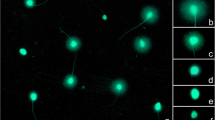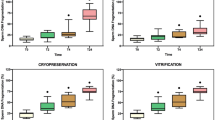Abstract
Aim
The purpose of the study was to evaluate the impact of seminal plasma in human ejaculates on the sperm DNA quality and DNA longevity.
Methods
Semen samples for this study were obtained from 20 donors with a normal spermiogram. Following centrifugation, the sperm pellet was resuspended either in the seminal plasma proceeding from its respective donor, or in an equal amount of PBS, adjusting the concentration to 50 × 106/ml. Each set of samples was incubated at 37 °C for 24 h and the sperm DNA damage was assessed using the chromatin-dispersion test following 0, 2, 6, and 24 h of incubation.
Results
Sperm DNA fragmentation (SDF) did not differ between the two experimental conditions at T0; however, Kaplan–Meier estimates to test for survival showed an statistical significant increase of SDF in the seminal plasma group when compared to the PBS group following all timeframes (p 0.000). With respect to sperm DNA longevity, the most dramatic loss of sperm DNA quality occurred during the first 2 h of incubation, with the rate of SDF (rSDF) in the seminal plasma being 2.1 more intense than in PBS. Interestingly, the rSDF was found to vary significantly between individuals, which was confirmed with significant correlations in all rSDF timeframes (rSDF T0–2, p 0.049; rSDF T2–6, p 0.000; rSDF T6–24: p 0.000).
Conclusions
Co-incubation of semen samples in seminal plasma after ejaculation increases iatrogenic sperm damage. This effect is statistically significant after 2 h of co-incubation. Subsequently, for ART purposes seminal plasma must be quickly removed after ejaculation–liquefaction, to avoid a higher susceptibility of sperm DNA towards fragmentation.


Similar content being viewed by others
References
Ajduk A, Zernicka-Goetz M (2013) Quality control of embryo development. Mol Asp Med 34(5):903–918. https://doi.org/10.1016/j.mam.2013.03.001
Simon L, Murphy K, Shamsi MB, Liu L, Emery B, Aston KI, Hotaling J, Carrell DT (2014) Paternal influence of sperm DNA integrity on early embryonic development. Hum Reprod 29(11):2402–2412. https://doi.org/10.1093/humrep/deu228
Alvarez Sedó C, Bilinski M, Lorenzi D, Uriondo H, Noblía F, Longobucco V, Lagar EV, Nodar F (2017) Effect of sperm DNA fragmentation on embryo development: clinical and biological aspects. JBRA Assist Reprod 21(4):343–350. https://doi.org/10.5935/1518-0557.20170061
Bhattacharya SM (2008) Association of various sperm parameters with unexplained repeated early pregnancy loss—which is most important? Int Urol Nephrol 40(2):391–395
Gosálvez J, Johnston S, López-Fernández C, Gosálbez A, Arroyo F, Fernández JL, Álvarez JG (2014) Sperm fractions obtained following density gradient centrifugation in human ejaculates show differences in sperm DNA longevity. Asian Pac J Reprod 3(2):116–120. https://doi.org/10.1016/S2305-0500(14)60014-2
Esteves SC, Sharma RK, Gosálvez J, Agarwal A (2014) A translational medicine appraisal of specialized andrology testing in unexplained male infertility. Int Urol Nephrol 46(6):1037–1052. https://doi.org/10.1007/s11255-014-0715-0
López G, Lafuente R, Checa MA, Carreras R, Brassesco M (2013) Diagnostic value of sperm DNA fragmentation and sperm high-magnification for predicting outcome of assisted reproduction treatment. Asian J Androl 15(6):790–794. https://doi.org/10.1038/aja.2013.81
Maxwell WM, de Graaf SP, Ghaoui Rel-H, Evans G (2007) Seminal plasma effects on sperm handling and female fertility. Soc Reprod Fertil Suppl 64:13–38
Boitrelle F, Albert M, Theillac C, Ferfouri F, Bergere M, Vialard F, Wainer R, Bailly M, Selva J (2012) Cryopreservation of human spermatozoa decreases the number of motile normal spermatozoa, induces nuclear vacuolization and chromatin decondensation. J Androl 33(6):1371–1378. https://doi.org/10.2164/jandrol.112.016980
Martínez-Soto JC, Landeras J, Gadea J (2013) Spermatozoa and seminal plasma fatty acids as predictors of cryopreservation success. Andrology 1(3):365–375. https://doi.org/10.1111/j.2047-2927.2012.00040.x
Fabozzi G, Starita MF, Rega E, Alteri A, Colicchia A, Piscitelli C, Giannini P (2016) Evaluation of the efficiency of two different freezing media and two different protocols to preserve human spermatozoa from cryoinjury. Int J Reprod Med 2016:6059757. https://doi.org/10.1155/2016/6059757
Tvrdá E, López-Fernández C, Sánchez-Martín P, Gosálvez J (2018) Sperm DNA fragmentation in donors and normozoospermic patients attending for a first spermiogram: static and dynamic assessment. Andrologia. https://doi.org/10.1111/and.12986
Bedford JM (2015) The functions—or not—of seminal plasma? Biol Reprod 92(1):1–3. https://doi.org/10.1095/biolreprod.114.126045
Crawford G, Ray A, Gudi A, Shah A, Homburg R (2015) The role of seminal plasma for improved outcomes during in vitro fertilization treatment: review of the literature and meta-analysis. Hum Reprod Update 21(2):275–284. https://doi.org/10.1093/humupd/dmu052
de la Torre J, Sánchez-Martín P, Gosálvez J, Crespo F (2017) Equivalent seminal characteristics in human and stallion at first and second ejaculated fractions. Andrologia 49(8):e12708. https://doi.org/10.1111/and.12708
Intasqui P, Antoniassi MP, Camargo M, Nichi M, Carvalho VM, Cardozo KH, Zylbersztejn DS, Bertolla RP (2015) Differences in the seminal plasma proteome are associated with oxidative stress levels in men with normal semen parameters. Fertil Steril 104(2):292–301. https://doi.org/10.1016/j.fertnstert.2015.04.037
Guz J, Gackowski D, Foksinski M, Rozalski R, Zarakowska E, Siomek A, Szpila A, Kotzbach M, Kotzbach R, Olinski R (2013) Comparison of oxidative stress/DNA damage in semen and blood of fertile and infertile men. PLoS ONE 8(7):e68490. https://doi.org/10.1371/journal.pone.0068490
Hosen MB, Islam MR, Begum F, Kabir Y, Howlader MZ (2015) Oxidative stress induced sperm DNA damage, a possible reason for male infertility. Iran J Reprod Med 13(9):525–532
Yamauchi Y, Ajduk A, Riel JM, Ward MA (2007) Ejaculated and epididymal mouse spermatozoa are different in their susceptibility to nuclease-dependent DNA damage and in their nuclease activity. Biol Reprod 77:636–647
Fernandez-Encinas A, García-Peiró A, Ribas-Maynou J, Abad C, Amengual MJ, Navarro J, Benet J (2016) Characterization of nuclease activity in human seminal plasma and its relationship to semen parameters, sperm DNA fragmentation and male infertility. J Urol 195(1):213–219. https://doi.org/10.1016/j.juro.2015.07.089
Cooper TG, Noonan E, von Eckardstein S, Auger J, Baker HW, Behre HM, Haugen TB, Kruger T, Wang C, Mbizvo MT, Vogelsong KM (2010) World Health Organization reference values for human semen characteristics. Hum Reprod Update 16:231–245. https://doi.org/10.1093/humupd/dmp048
Gosálvez J, Caballero P, López-Fernández C, Ortega L, Guijarro JA, Fernández JL, Johnston SD, Nuñez-Calonge R (2013) Can DNA fragmentation of neat or swim-up spermatozoa be used to predict pregnancy following ICSI of fertile oocyte donors? Asian J Androl 15(6):812–818. https://doi.org/10.1038/aja.2013.74
Zhao J, Zhang Q, Wang Y, Li Y (2014) Whether sperm deoxyribonucleic acid fragmentation has an effect on pregnancy and miscarriage after in vitro fertilization/intracytoplasmic sperm injection: a systematic review and meta-analysis. Fertil Steril 102(4):998–1005.e8. https://doi.org/10.1016/j.fertnstert.2014.06.033
Zhang Z, Zhu L, Jiang H, Chen H, Chen Y, Dai Y (2015) Sperm DNA fragmentation index and pregnancy outcome after IVF or ICSI: a meta-analysis. J Assist Reprod Genet 32(1):17–26. https://doi.org/10.1007/s10815-014-0374-1
Kussler APS, Pimentel AM, Alcoba DD, Liu IP, Brum IS, Capp E, Corleta HVE (2014) Mechanical processing of hyperviscous semen specimens can negatively affect sperm DNA fragmentation. Int Urol Nephrol 46(4):737–742. https://doi.org/10.1007/s11255-013-0578-9
Esteves SC, Gosálvez J, López-Fernández C, Núñez-Calonge R, Caballero P, Agarwal A, Fernández JL (2015) Diagnostic accuracy of sperm DNA degradation index (DDSi) as a potential noninvasive biomarker to identify men with varicocele-associated infertility. Int Urol Nephrol 47(9):1471–1477. https://doi.org/10.1007/s11255-015-1053-6
Ben WX, Fu MT, Mao LK, Ming ZW, Xiong WW (1997) Effects of various concentrations of native seminal plasma in cryoprotectant on viability of human sperm. Arch Androl 39(3):211–216
Kobayashi M, Hori T, Kawakami E (2013) Changes in prostaglandin E2 levels in seminal plasma during ejaculation and the effect of exogenous prostaglandin E2 on semen volume in the dog. J Vet Med Sci 75(9):1249–1252. https://doi.org/10.1292/jvms.13-0053
Akcay E, Reilas T, Andersson M, Katila T (2006) Effect of seminal plasma fractions on stallion sperm survival after cooled storage. J Vet Med A 53(9):481–485. https://doi.org/10.1111/j.1439-0442.2006.00882.x
Benchaib M, Braun V, Lornage J, Hadj S, Salle B, Lejeune H, Guérin JF (2003) Sperm DNA fragmentation decreases the pregnancy rate in an assisted reproductive technique. Hum Reprod 18(5):1023–1028. https://doi.org/10.1093/humrep/deg228
Manjunath P, Bergeron A, Lefebvre J, Fan J (2007) Seminal plasma proteins: functions and interaction with protective agents during semen preservation. Soc Reprod Fertil Suppl 65:217–228
Brachtchenko J, Moskovstev S, Swanson S, Shlush E, Kan-Ool L, Sharma P, Baratz AY, Glass K, Librach CL (2015) Significant correlation between sperm DNA damage and achieving a pregnancy in 1847 non-IVF fertility treatment cycles. Fertil Steril 104(3):e297
Wdowiak A, Bojar I (2016) Relationship between pregnancy, embryo development, and sperm deoxyribonucleic acid fragmentation dynamics. Saudi J Biol Sci 23(5):598–606. https://doi.org/10.1016/j.sjbs.2015.08.001
Har-Vardi I, Mali R, Breietman M, Sonin Y, Albotiano S, Levitas E, Potashnik G, Priel E (2007) DNA topoisomerases I and II in human mature sperm cells: characterization and unique properties. Hum Reprod 22(8):2183–2189. https://doi.org/10.1093/humrep/dem170
Har-Vardi I, Breitman M, Potashnik G, Priel E (1999) Characterization of DNA topoisomerases in human sperm cells. Hum Reprod 14(Suppl 3):33. https://doi.org/10.1093/humrep/14.Suppl_3.33
Shaman JA, Prisztoka R, Ward WS (2006) Topoisomerase IIB and an extracellular nuclease interact to digest sperm DNA in an apoptotic-like manner. Biol Reprod 75(5):741–748. https://doi.org/10.1095/biolreprod.106.055178
Sotolongo B, Huang TT, Isenberger E, Ward WS (2005) An endogenous nuclease in hamster, mouse, and human spermatozoa cleaves DNA into loop-sized fragments. J Androl 26(2):272–280. https://doi.org/10.1002/j.1939-4640.2005.tb01095.x
Knuth UA, Kühne J, Bals-Pratsch M, Nieschlag E (1988) Intra-individual variation of sperm velocity, linearity, lateral head displacement and beat frequency in healthy volunteers. Andrologia 20(3):243–248. https://doi.org/10.1111/j.1439-0272.1988.tb01065.x
Auger J, Eustache F, Ducot B, Blandin T, Daudin M, Diaz I, Matribi SE, Gony B, Keskes L, Kolbezen M, Lamarte A, Lornage J, Nomal N, Pitaval G, Simon O, Virant-Klun I, Spira A, Jouannet P (2000) Intra- and inter-individual variability in human sperm concentration, motility and vitality assessment during a workshop involving ten laboratories. Hum Rep 15(11):2360–2368. https://doi.org/10.1093/humrep/15.11.2360
Dere E, Huse S, Hwang K, Sigman M, Boekelheide K (2016) Intra- and inter-individual differences in human sperm DNA methylation. Andrology 4(5):832–842. https://doi.org/10.1111/andr.12170
Funding
This study was funded by the Spanish Ministry of Economy, Industry and Competitiveness - Programa Retos RTC-2016-4733-1 and by the Slovak Research and Development Agency Grant No APVV-15-0544. The funding bodies had no involvement in the study.
Author information
Authors and Affiliations
Corresponding author
Ethics declarations
Conflict of interest
The authors declare no financial or personal conflicts of interest that might affect any aspect of this study.
Ethical approval
All procedures performed in the study were in accordance with the ethical standards of the institutional research committee, with the 1964 Helsinki declaration and its later amendments or comparable ethical standards.
Informed consent
Informed consent was obtained from all individual participants included in the study.
Rights and permissions
About this article
Cite this article
Tvrdá, E., Arroyo, F. & Gosálvez, J. Dynamic assessment of human sperm DNA damage I: the effect of seminal plasma-sperm co-incubation after ejaculation. Int Urol Nephrol 50, 1381–1388 (2018). https://doi.org/10.1007/s11255-018-1915-9
Received:
Accepted:
Published:
Issue Date:
DOI: https://doi.org/10.1007/s11255-018-1915-9




